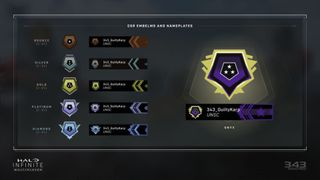343 wants Halo Infinite ranked to work, but there's a long way to go
A lengthy blog post answered some questions about Halo Infinite ranked, announced the Champion tier, and dredged up more drama

343 Industries really wants to get Halo Infinite ranked right. After resetting every player's ranking last month in an effort to fix what was considered an overly generous system, 343 Industries recently released a lengthy blog post to further explain how the new system works. This is likely in response to players suggesting the ranked rework would be a waste of time without certain fixes, and the community's lingering questions about the system in general.
And while the Halo Waypoint post does clarify certain key details, there are still some aspects of Halo Infinite ranked that need work and/or clarification. 343 recognizes this, as laid out in the post, but will players stick around long enough to wait for these fixes to be implemented? Let's look at exactly how Halo Infinite ranked works as well as outline its persistent issues.
Understanding Halo Infinite ranked


Halo Infinite ranked is going to ruin my life and I'm okay with it
Halo Infinite has several systems designed to balance and control its ranked playlist. TrueSkill2 is a rating system that helps understand "accurately and quickly" how skilled players are relative to others, while TrueMatch is the "special sauce" that makes the "best possible matches" out of those players for each game. TrueSkill2 uses data like wins, losses, kills, and deaths to understand each player's skill relative to every other player's skill, the results of which spit out your MMR, or matchmaking rating.
There are two types of ratings at work in Halo Infinite: MMR, the hidden numerical representation of your skill in a specific playlist; and CSR (competitive skill rank), which is the ranking you see as a player. As of the time of writing, there are six CSR ranks which each have six sub-ranks within them: Bronze, Gold, Platinum, Diamond, and Onyx – though 343 has promised a Champion rank will be added in "future seasons."
Your CSR will never go down on a win or up on a loss, but over time your CSR will "always trend towards your MMR," so that your visible ranking is indicative of your skill as determined by the TrueSkill2 system. If your CSR is far from your MMR, you'll see larger gains and losses of CSR, which can be up to +15 if you win and -15 if you lose. You'll also see larger gains and losses depending on how you fare against higher-skilled and lesser-skilled players.
343 Industries explains why there are two separate ranking systems rather than just showing players their MMR, stating that "due to the nature of the TrueSkill2 system, changes to a player’s MMR don’t always correlate directly with short-term in-game outcomes. For example, you might play really well in a losing effort, in which case your skill rating (MMR) could go up, but it wouldn’t make sense for your rank (CSR) to go up on a loss."
As far as how these rankings work when finding matches, the TrueMatch system works in tandem with Xbox Live's SmartMatch and 343's own services to find players the best match possible by considering both skill and latency. TrueMatch uses the skill you have in the playlist in which you're searching for a game to ensure the fairest matches possible without having to wait for eternity – which 343 points out is incredibly difficult to do when also searching for low datacenter pings.
Sign up to the GamesRadar+ Newsletter
Weekly digests, tales from the communities you love, and more
It's clear that there are several complex, interwoven systems in place when it comes to Halo Infinite ranking and the matchmaking within that playlist. But this lengthy blog post's attempts to answer questions has inadvertently dredged up new questions – specifically around MMR and CSR, which still have major discrepancies that worry players.
The lingering issues

One of the biggest issues in Halo Infinite ranked play centers around players exploiting MMR in order to get into easier ranked matches. In an FAQ section at the end of the Halo Waypoint blog, 343 admits that it "leverages your performance in social to build a baseline/starting point" for ranked matchmaking in "some instances," likening it to determining someone's skill as a runner before a 200m race by referencing previous 200m race times.
"For cross-playlist skill seeding we rely on historical data to figure out which playlists have strong correlation, and how strong that correlation is at various skill levels," it explains. This likely means that your performance in Team Slayer matches will have more of a say in your ranked matchmaking experience during initial placement matches than, say, your Big Team Battle performance.
But players exploit this system by purposefully throwing matches in social playlists and bot matches before jumping into ranked placement in order to get easier matches, as suggested by Reddit user RealSonZoo's research. And while 343 recognizes the system "isn't flawless," the devs offer no details on how they'll fix this in the future, just that they're "continuing to fine-tune this part of our matchmaking process." In answering another question about players encountering these "outliers" in ranked matches, 343 suggests that these can crop up due to unfinished placement matches, or a player partied up with a much more skilled friend.
But there's no outright acknowledgement that players are exploiting the MMR/CSR system to get easier ranked matches, only a vague reference that "those aren't the only two reasons why this can happen," and a promise that the devs are "investigating to see which values we can tune in order to create more fair and competitive matches in ranked."
A Reddit response to the Halo Waypoint post also suggests that the current system promotes an increase in play time in order to offset slower progression. In the blog, 343 responds to a commonly asked question about players' ranks barely increasing for wins but dropping significantly for losses with: "it could be because you didn’t perform well in that match, your individual skill was higher than your opponents, or your CSR is currently over-ranked and the system is correcting itself." According to the dev team, "smaller gains and noticeable losses are meant to keep your CSR in-check in the long-run," but some players are reading that as a directive to play more for negligible increases in rank.
Whether that's true remains to be seen, but it's clear that 343's attempts to clarify Halo Infinite's ranked mode have both helped and hurt. It's great to see how everything works under the hood, and it's important that we as players understand how difficult matchmaking can be for devs, but the lack of outright acknowledgement of some of the glaring issues is frustrating. Ranked is a crucial mode that will help keep the game alive, and how 343 handles it going forward is imperative to Halo Infinite's continued success.
Halo Infinite's co-op delay is a blow, but it deserves to be done right
Alyssa Mercante is an editor and features writer at GamesRadar based out of Brooklyn, NY. Prior to entering the industry, she got her Masters's degree in Modern and Contemporary Literature at Newcastle University with a dissertation focusing on contemporary indie games. She spends most of her time playing competitive shooters and in-depth RPGs and was recently on a PAX Panel about the best bars in video games. In her spare time Alyssa rescues cats, practices her Italian, and plays soccer.
Most Popular



